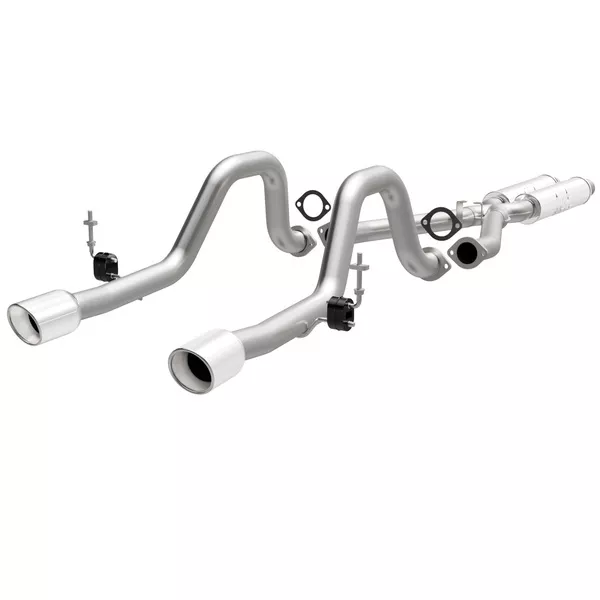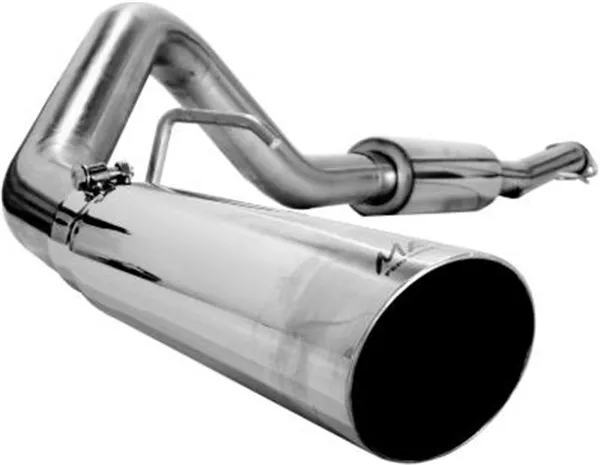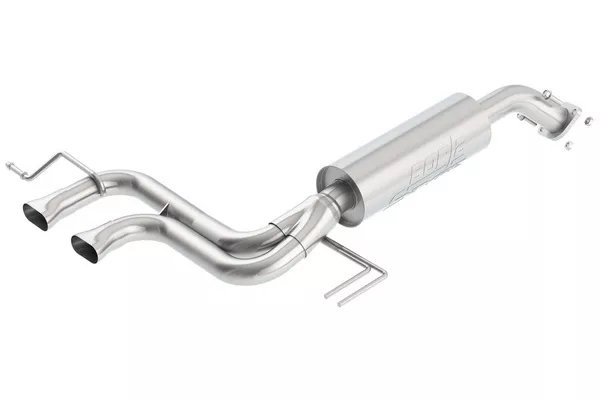The main functions of exhaust systems are increasing horsepower and improving your engine sound.
While stock exhaust systems are okay for this task, they only do the bare minimum.
Stock exhaust systems do not give the deep and aggressive growl most motor enthusiasts desire.
They also do not offer the best performance due to many reasons.
To improve this, you can opt to replace some parts of the exhaust system using aftermarket performance exhaust systems.
What are aftermarket performance exhaust systems?
Aftermarket performance exhausts are exhaust systems meant to replace the stock exhaust and offer more power and better tone to your engine.
Aftermarket exhaust systems come in various configurations. There are the header-back, turbo-back, axle-back and cat-back systems.
Today we’ll focus on the cat-back exhaust systems and what makes them stand out.
Definition of a cat-back exhaust system
The name “cat-back” refers to the parts of the exhaust system that are replaced during the configuration.
Cat-back exhaust systems replace all the components after the catalytic converter, sometimes referred to as the cat.
The components include the outlet pipe from the catalytic converter, the muffler, the tailpipe, and the exhaust tips.
Depending on the make and model, some cat-back systems also include the H-pipe, the Y-pipe, the X-pipe, or the mid-pipe.
Features of a cat-back exhaust system
- Mandrel-bent tubing reduces back pressure
- Glass pack or straight-through muffler
- Large diameter tubing
- Made of aluminized steel or stainless steel
- Lacks a resonator
- Fairly easy installation
Why should you choose a cat-back exhaust system?
1. Larger tube diameter
The cat-back exhaust system has a larger diameter piping compared to the stock and axle-back exhaust systems
Its tubing is also higher-grade mandrel bent. These two work together to offer better flow and allow the system to breathe better.
Note that, while large-diameter tubing is an advantage, it can also be a disadvantage if overdone.
Extremely large-diameter tubings result in a pile-up of exhaust gases and slow exit.
This can lead to a significant decrease in torque and horsepower as well as rpm.
But if you are making your order on partcatalog.com, you can always inquire about the recommended tube diameter for your exhaust system by providing your make and model.
2. Increased horsepower and torque for better performance
Because of the better flow of exhausts resulting from the mandrel-bent tubing and the larger diameter piping, cat-back exhaust systems manage to offer better performance.
The mandrel-bent tubing reduces the level of back pressure in the exhaust manifold as the larger diameter reduces restriction to the flow of exhausts.
As a result, the engine gets to breathe better and so release more torque and horsepower. Your engine’s performance and acceleration are then increased.
Though, the level of horsepower gained is not constant across all cat-back systems. It depends on the quality and performance of the catalytic converters.
Less restrictive catalytic converters paired with a cat-back exhaust system will offer high performance and power.
3. Deep, throaty, and aggressive sound
One function shared with both the axle-back and the cat-back exhaust systems are shaping your vehicle’s tone.
This is a little bit different from most original exhaust systems.
The original exhaust systems focus more on just reducing the sound and not shaping it to give it that desired deep growl.
The cat-back exhaust system on the other hand does both the moderation of noise and the shaping. The mufflers used are usually either straight-through or glass pack mufflers
- Glasspack muffler
Glasspack mufflers do not have extra sound-absorbing material. So, in order to absorb sound, they use the glass layer and packing.
These do not absorb a lot of sounds. As a result, the glass pack mufflers end up producing sounds that are more aggressive and louder than the straight-through muffler.
- Straight-through muffler
Straight-though mufflers are almost similar to glass pack. The only difference is that it features straight perforated pipes.
These exhaust pipes are usually wrapped in sound-absorbing materials, mostly fiberglass packing.
Though they absorb most of the sound, they still get to shape the sound and give that deep but slightly low sound.
The tone provided by different cat-back exhaust systems varies from one system to another.
There are those that will give you a deep and little bit low sound, while others will give obnoxious and a little loud growl.
Before settling on either of these, it is important to know what you want.
You should also do your research on the acceptable levels of noise in the area you intend to use the vehicle in.
4. Improved fuel economy
While getting a cat-back performance exhaust system can be pricier initially, it can save on a lot of costs in the future.
This is because, with a cat-back exhaust system, you will experience a significant increase in your fuel economy.
Since there is no back pressure and the diameter is large enough, the engine will not use a lot of energy to push the exhausts out.
This means there will be a reduction in the amount of load on the engine, leading to higher mpg and fuel efficiency.
The difference in fuel economy is, however, more obvious while driving on a freeway.
Driving in the streets will not amount to a significant difference unless you are one to stay on the road the whole day.
5. Corrosion and rust-resistant materials
When making a vehicle, most manufacturers focus on minimizing costs. In doing do, they sometimes use a lower quality metal, which can vary wildly depending on which vehicle you drive.
These OE materials are often not of the best quality.
In most cases, uncoated steel is used for the exhaust system. The material is open to oxidation and gets easily corroded or rusted.
This is not the case with most cat-back exhaust systems.
The materials are often 304 stainless steel or aluminized steel. The stainless steel is usually coated in special metals that make it corrosion-resistant.
However, stainless still can be very expensive, as opposed to aluminized steel which is very affordable. It is also resistant to corrosion, just not to the level of stainless steel.
Other benefits of aluminized steel is they are lightweight and very workable.
6. Budget-friendly option
Cat-back exhaust systems can be a little expensive. But, compared to the alternative, they are the easiest way of improving your vehicle’s performance without breaking the bank.
When it comes to improving your vehicle’s performance, you have two options.
One is to replace specific parts like with cat-back exhaust systems.
The other one is buying a whole new exhaust system.
Getting a cat-back exhaust system is definitely the more budget-friendly option.
Depending on what you choose, exhaust systems can vary between $350 to $3000.
7. Fairly easy installation
The installation of a cat-back exhaust system is fairly easy, but this too depends on your vehicle’s make and model.
Most cat-back exhaust systems are customized and not universal.
This means they are made for the specific vehicle which makes it easier to fit.
They usually bolt directly to where the replaced parts had been without requiring further modification.
8. Allowance to improve the performance even more.
A performance exhaust system, like the cat-back exhaust, allows for easy splitting into dual exhaust.
This offers even more breathing space for the engine thus better performance.
But it is easy to mistake a dual exit exhaust for a dual exhaust system.
You should know the difference between a dual exhaust and a dual exit exhaust system.
The difference is that the dual exhaust system has two exhaust systems on one vehicle.
After the emissions are channeled out from the cylinders by the exhaust manifold, they are deposited into different catalytic converters. From there they are processed by different exhaust systems.
A dual exit on the other hand, is just a single exhaust system but with two exhaust tips.
Cat-back exhaust vs axle-back exhaust vs OEM exhaust
Cat-back exhaust system vs axle-back exhaust system
Cat-back and axle-back exhaust systems are both aftermarket exhaust systems.
They both improve your engine’s tone and give it that deep rumble loved by every motor enthusiast.
But the difference between the two is the parts that are usually replaced.
As mentioned before, a cat-back exhaust includes the outlet pipe from the catalytic converter, the muffler, the tailpipe, and the exhaust tips.
Axle-back, on the other hand, includes the components after the rear axle. These are the muffler, tailpipe, and exhaust tips.
It does not include the catalytic converter outlet exhaust pipes.
The axle-back exhaust system uses the factory exhaust pipe which does not have a large diameter.
Because of this, the axle-back exhaust system does not impact the flow or pressure of the exhaust gases in any way.
It only gets to impact the tone of the vehicle’s engine.
One of the things you would appreciate about the axle-back exhaust system is that it offers better sound improvement.
It is also more affordable and easier to install than other types of exhaust systems, including the cat-back exhaust system.
Cat-back exhaust system vs factory exhaust system
A stock system is designed to reduce and if possible eliminate all the noise produced by your vehicle.
As a result, they are fitted with both a muffler and a resonator.
For the noises that the muffler fails to get rid of, the resonator eliminates them.
But the problem with a resonator is that it can cause restriction to the flow of the exhausts. In the end, this can end up lowering your vehicle’s performance.
The resonator can also affect your fuel efficiency.
But both cons of a resonator are not present with a cat-back exhaust system.
Another difference is with the material used in the cat-back exhaust system against that in stock exhaust systems.
The factory exhausts come in mandrel bent tubes made of stainless steel or aluminized steel. Besides offering longer durability, the construction also ensures there’s free flow of gases.
OEM exhaust systems on the other and have crush-bent tubing made of normal steel.
One main reason for choosing to remain with a stock system is because it comes already installed on your vehicle. Thus it saves you the hassle of installing new parts.
So, if you are okay with the sound and performance then you have no need to replace your original exhaust system.





